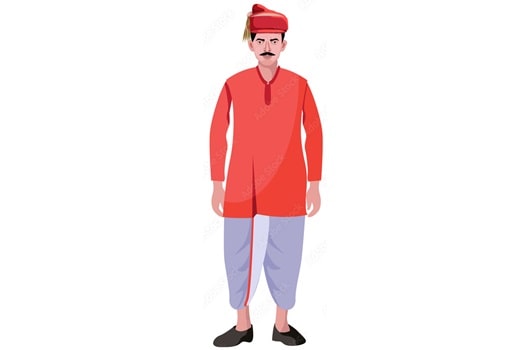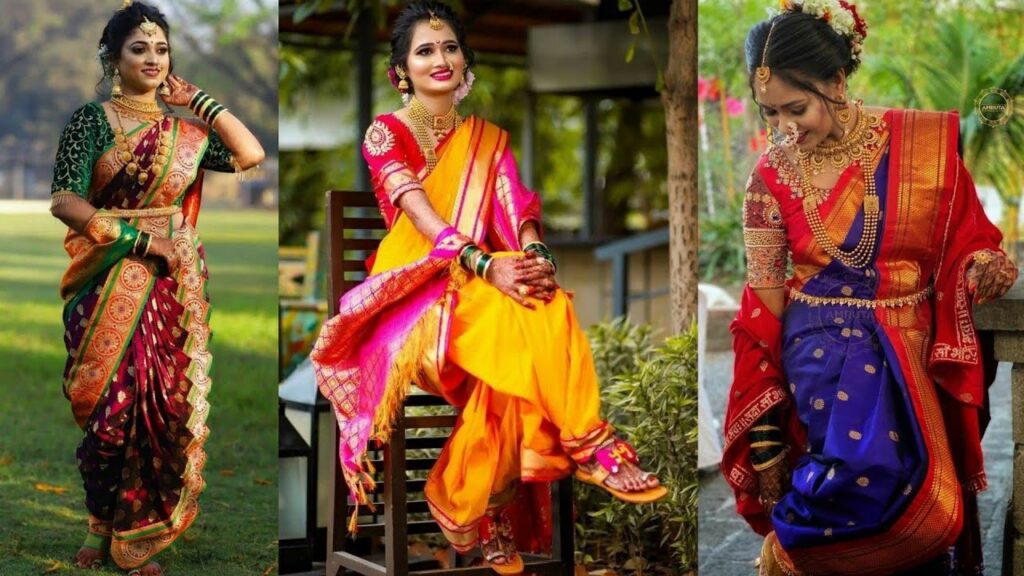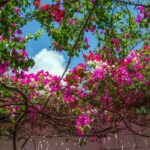Have you ever wondered about the traditional dress of Maharashtra? Maharashtra, known for its vibrant folk music, rich literature, diverse cuisine, and the lively lezim dance, offers a glimpse into its cultural heritage through its traditional attire. The traditional dress of Maharashtra for both men and women is a blend of practicality and elegance, reflecting the region’s agricultural roots and climate. In this article, we will explore the traditional dress of Maharashtra for both genders.
Traditional Dress of Maharashtra for Men

1. Dhoti-Kurta with Feta (Turban)
In Maharashtra, men typically wear a dhoti and kurta as their traditional attire. The dhoti is a distinctive piece of cloth wrapped around the waist with five knots, and the loose end is folded at the back. These dhotis are usually white or saffron, making them suitable for ceremonial and ritual occasions.
The kurta is a short cotton garment worn over the dhoti. Given Maharashtra’s hot and humid climate, cotton is the preferred fabric as it absorbs sweat and keeps the wearer cool. The kurta is usually white, complementing the dhoti and offering a classic and comfortable look.
The feta, or turban, is a headgear worn to protect against the intense heat. Typically made from light-colored fabric, the feta is worn during special occasions such as weddings, poojas, and cultural festivals. It symbolizes pride, respect, and honor.
2. Bandi
The bandi is a waistcoat worn over the kurta. These sleeveless jackets add a formal touch to the traditional dress of Maharashtra. Typically made from cotton to suit the warm weather, bandis come in various designs and offer a blend of traditional and modern aesthetics. They are often worn during festivals and special events, enhancing the overall appearance with their elegant touch.
Traditional Dress of Maharashtra for Women
1. Sarees
A quintessential Maharashtrian look involves the 9-yard-long saree, known as ‘Nauvari’ in Marathi. The unique draping style of the Nauvari saree allows for comfort and freedom of movement, with the lower part of the saree tucked in a dhoti-like fashion. The Paithani saree, originating from Aurangabad, is renowned for its handwoven silk, vibrant colors, and intricate designs. Peshwai sarees, with their royal look and rich patterns, reflect the grandeur of the Maratha regime. Karvat kathi sarees feature floral and fauna-inspired borders, known for their elegance and scissor-cut designs.
2. Ghagra and Choli
For festive and bridal attire, women often wear a ghagra (a long flowing skirt) paired with a choli (a short-sleeved blouse) and dupatta (a scarf). This traditional dress of Maharashtra is particularly popular during celebrations. The choli is designed to match the ghagra, and together with the half-draped saree, it creates a beautiful ensemble. Often, the sarees are in vibrant colors like red or green, with cholis that complement these hues, enhancing the wearer’s appearance.
3. Himroo and Mashru Fabrics
Himroo and Mashru are traditional fabrics from Aurangabad, Maharashtra. Himroo is known for its luxurious texture, while Mashru is a blend of cotton and silk with a shiny finish. These fabrics are commonly used in sarees and shawls, offering a touch of opulence and tradition.
4. Footwear
Kolhapuri chappals are famous footwear from Kolhapur District in Maharashtra. Renowned for their durability, these chappals are crafted from various materials, including cotton for regular wear and silk for special occasions. Their longevity and comfort make them a staple in traditional attire.
5. Jewellery
Traditional Maharashtrian jewelry includes the ‘Nath,’ an ornate nose ring often worn with the Nauvari saree. Made of gold, it adds a distinctive touch to the attire. Married women in Maharashtra also wear green bangles, gold or silver necklaces, and toe rings, which symbolize prosperity and are believed to strengthen the uterus.
Conclusion
The traditional dress of Maharashtra for both men and women plays a crucial role in preserving the cultural heritage of the region. Despite the influences of urbanization and Western fashion, the traditional attire remains cherished, especially in rural and tribal areas where comfort and tradition take precedence over style. Protecting and celebrating these traditional garments and their associated customs is vital for maintaining Maharashtra’s rich cultural identity.


